An Experimental Analysis of Microcrack Generation during Hydraulic Fracturing of Shale
Abstract
:1. Introduction
2. Microcracks Generated along the Fractures
2.1. Shale Fracturing in the Experiment
2.2. Microcrack Traces
2.3. Distribution of Microcrack Lengths
2.4. Distribution of the Branching Numbers
3. Mechanics of Microcrack Formation at the Fracture Face
3.1. Possibility of Microcrack Formation by the Fracturing Fluid
3.2. Microcrack Formation in the Process of Hydraulic Fracture Growth by Singular Stresses at Its Contour
4. Anisotropy in Fracture Toughness
5. Conclusions
Author Contributions
Funding
Institutional Review Board Statement
Informed Consent Statement
Data Availability Statement
Conflicts of Interest
References
- Ross, D.; Mar, R. The importance of shale composition and pore structure upon gas storage potential of shale gas reservoirs. Mar. Petrol. Geol. 2009, 26, 916–927. [Google Scholar] [CrossRef]
- Bernard, S.; Wirth, R.; Schreiber, A.; Schulz, H.; Horsfield, B. Formation of nanoporous pyrobitumen residues during maturation of the Barnett Shale (Fort Worth Basin). Int. J. Coal. Geol. 2021, 103, 3–11. [Google Scholar] [CrossRef]
- Zhou, J.; Xue, C. Experimental Investigation of Fracture Interaction between Natural Fractures and Hydraulic Fracture in Naturally Fractured Reservoirs. In Proceedings of the 73rd European Association of Geoscientists and Engineers Conference and exhibition, Vienna, Austria, 23 May 2011. [Google Scholar]
- Altammar, M.J.; Sharma, M.M.; Manchanda, R. The effect of pore pressure on hydraulic fracture growth: An experimental study. Rock Mech. Rock Eng. 2018, 51, 2709–2732. [Google Scholar] [CrossRef]
- Guo, T.; Zhang, S.; Qu, Z.; Zhou, T.; Xiao, Y.; Gao, J. Experimental study of hydraulic fracturing for shale by stimulated reservoir volume. Fuel 2014, 128, 373–380. [Google Scholar] [CrossRef]
- He, J.; Lin, C.; Li, X.; Zhang, Y.; Chen, Y. Initiation, propagation, closure and morphology of hydraulic fractures in sandstone cores. Fuel 2017, 208, 65–70. [Google Scholar] [CrossRef]
- Zhao, Z.; Li, X.; He, J.; Mao, T.; Zheng, B.; Li, G. A laboratory investigation of fracture propagation induced by supercritical carbon dioxide fracturing in continental shale with interbeds. J. Petrol. Sci. Eng. 2018, 166, 739–746. [Google Scholar] [CrossRef]
- Lecampion, B.; Bunger, A.; Zhang, X. Numerical methods for hydraulic fracture propagation: A review of recent trends. J. Nat. Gas Sci. Eng. 2017, 49, 66–83. [Google Scholar] [CrossRef] [Green Version]
- Teufel, L.; Clark, J. Hydraulic Fracture Propagation in Layered Rock: Experimental Studies of Fracture Containment. SPE J. 1984, 24, 19–32. [Google Scholar] [CrossRef] [Green Version]
- Tan, P.; Jin, Y.; Han, K.; Hou, B.; Chen, M.; Gu, X.; Gao, J. Analysis of hydraulic fracture initiation and vertical propagation behavior in laminated shale formation. Fuel 2017, 206, 482–493. [Google Scholar] [CrossRef]
- Ishid, T.; Aoyagi, K.; Niwa, T.; Chen, Y.; Murata, S.; Chen, Q.; Nakayam, Y. Acoustic emission monitoring of hydraulic fracturing laboratory experiment with supercritical and liquid CO2. Geophys. Res. Lett. 2012, 39, 16309. [Google Scholar] [CrossRef] [Green Version]
- Bennour, Z.; Ishida, T.; Nagaya, Y.; Chen, Y.; Nara, Y.; Chen, Q. Crack extension in hydraulic fracturing of shale cores using viscous oil, water, and liquid CO2. Rock Mech. Rock Eng. 2015, 48, 1463–1473. [Google Scholar] [CrossRef] [Green Version]
- He, J.; Li, X.; Yin, C.; Zhang, Y.; Lin, C. Propagation and characterization of the micro cracks induced by hydraulic fracturing in shale. Energy 2020, 191, 116449. [Google Scholar] [CrossRef]
- Hampton, J.; Gutierrez, M.; Matzar, L. Microcrack Damage Observations near Coalesced Fractures Using Acoustic Emission. Rock Mech. Rock Eng. 2019, 52, 3597–3608. [Google Scholar] [CrossRef]
- Stanchits, S.; Burghardt, J.; Surdi, A. Hydraulic fracturing of heterogeneous rock monitored by acoustic emission. Rock Mech. Rock Eng. 2015, 48, 2513–2527. [Google Scholar] [CrossRef]
- Garagash, D.; Detournay, E. The tip region of a fluid-driven fracture in an elastic medium. J. Mech. 2000, 67, 183–192. [Google Scholar] [CrossRef]
- Bunger, A.P.; Detournay, E.; Jeffrey, R.G. Crack tip behavior in near-surface fluid-driven fracture experiments. Comptes Rendus Mécanique 2005, 333, 299–304. [Google Scholar] [CrossRef]
- Chitrala, Y.; Moreno, C.; Sondergeld, C.H.; Rai, C. Microseismic and Microscopic Analysis of Laboratory Induced Hydraulic Fractures. In Proceedings of the Society of Petroleum engineers-Canadian Uncoventional Resources Conference, Calgary, AB, Canada, 17 November 2011. [Google Scholar]
- Kumari, W.; Ranjith, P.; Perera, M.; Li, X.; Li, L.; Chen, B.; Isaka, B.; De Silva, V. Hydraulic fracturing under high temperature and pressure conditions with micro CT applications: Geothermal energy from hot dry rocks. Fuel 2018, 230, 138–154. [Google Scholar] [CrossRef]
- Maxwell, S.C.; Urbancic, T.I.; Steinsberger, N.; Zinno, R. Microseismic Imaging of Hydraulic Fracture Complexity in the Barnett Shale. In Proceedings of the 2002 SPE Annual Technocal Coference and Exhibition, San Antonio, TX, USA, 29 September 2002. [Google Scholar]
- Ishida, T. Acoustic emission monitoring of hydraulic fracturing in laboratory and field. Constr. Build. Mater. 2001, 15, 283–295. [Google Scholar] [CrossRef]
- Stoeckhert, F.; Molenda, M.; Brenne, S.; Alber, M. Fracture propagation in sandstone and slate—Laboratory experiments, acoustic emissions and fracture mechanics. J. Rock Mech. Geotech. Eng. 2015, 7, 237–249. [Google Scholar] [CrossRef] [Green Version]
- Ishida, T.; Chen, Q.; Mizuta, Y. Effect of injected water on hydraulic fracturing deduced from acoustic emission monitoring. Pure Appl. Geophys. 1997, 150, 627–646. [Google Scholar] [CrossRef]
- Gonçalves, B.; Einstein, H. Physical processes involved in the laboratory hydraulic fracturing of granite: Visual observations and interpretation. Eng. Fract. Mech. 2018, 191, 125–142. [Google Scholar] [CrossRef]
- Hampton, J.; Gutierrez, M.; Matzar, L.; H, D.; Frash, L. Acoustic emission characterization of microcracking in laboratory-scale hydraulic fracturing tests. J. Rock Mech. Geotech. Eng. 2018, 10, 805–817. [Google Scholar] [CrossRef]
- Li, B.; Gonçalves, B.; Einstein, H. Laboratory hydraulic fracturing of granite: Acoustic emission observations and interpretation. Eng. Fract. Mech. 2019, 209, 200–220. [Google Scholar] [CrossRef]
- Brady, B.H.G.; Brown, E.T. Rock Mechanics for Underground Mining; George Allen and Unwin: London, UK; Boston, MA, USA; Sydney, Australia, 1985. [Google Scholar]
- Sih, G.C.; Liebowitz, H. Mathematical theories of brittle fracture. In Fracture, an Advanced Treatise; Liebowitz, H., Ed.; Mathematical Fundamentals; Academic Press: New York, NY, USA; London, UK, 1986; Volume II, pp. 68–191. [Google Scholar]
- Dyskin, A.V. Crack growth criteria incorporating non-singular stresses: Size effect in apparent fracture toughness. Int. J. Fract. 1997, 83, 191–206. [Google Scholar] [CrossRef]
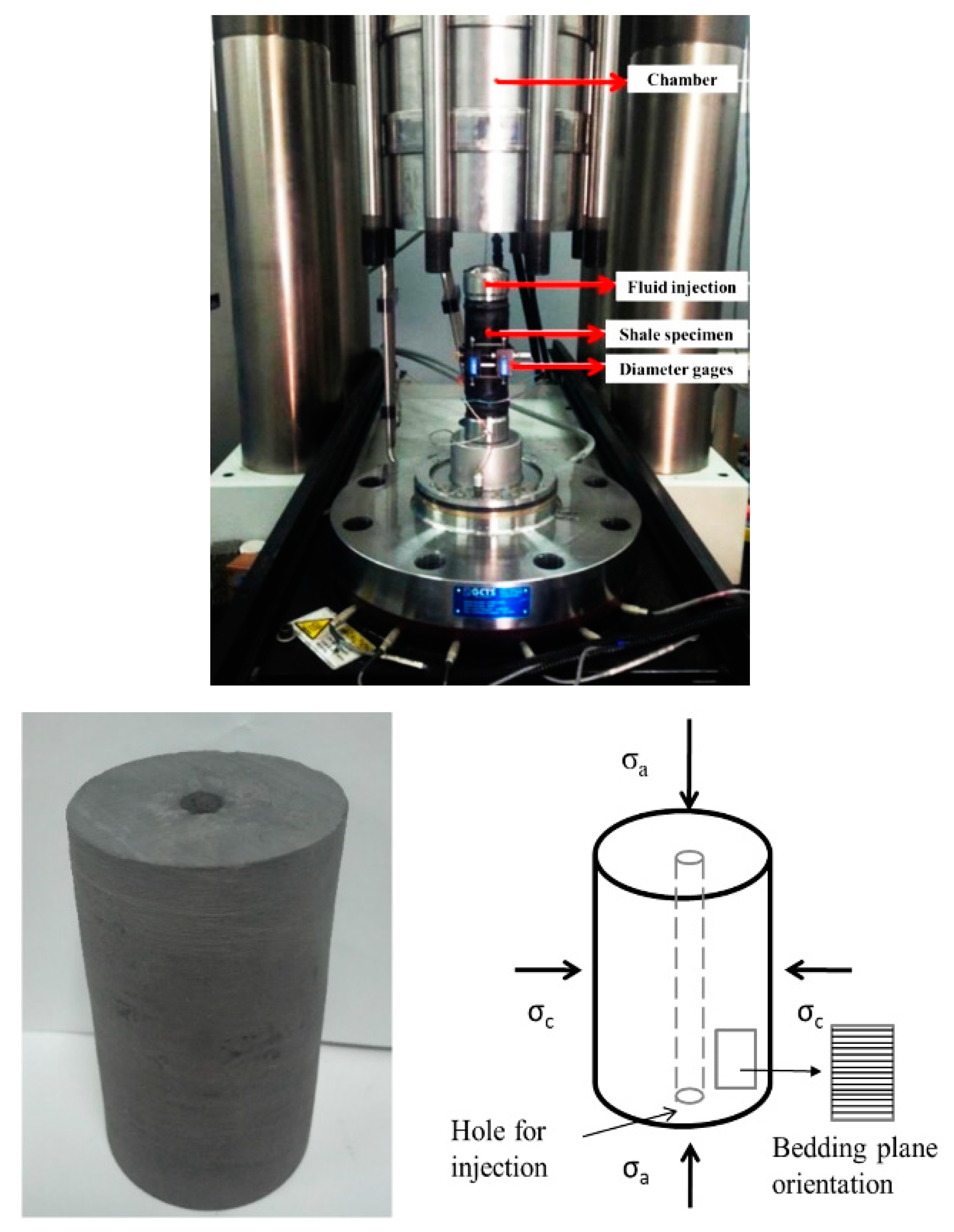
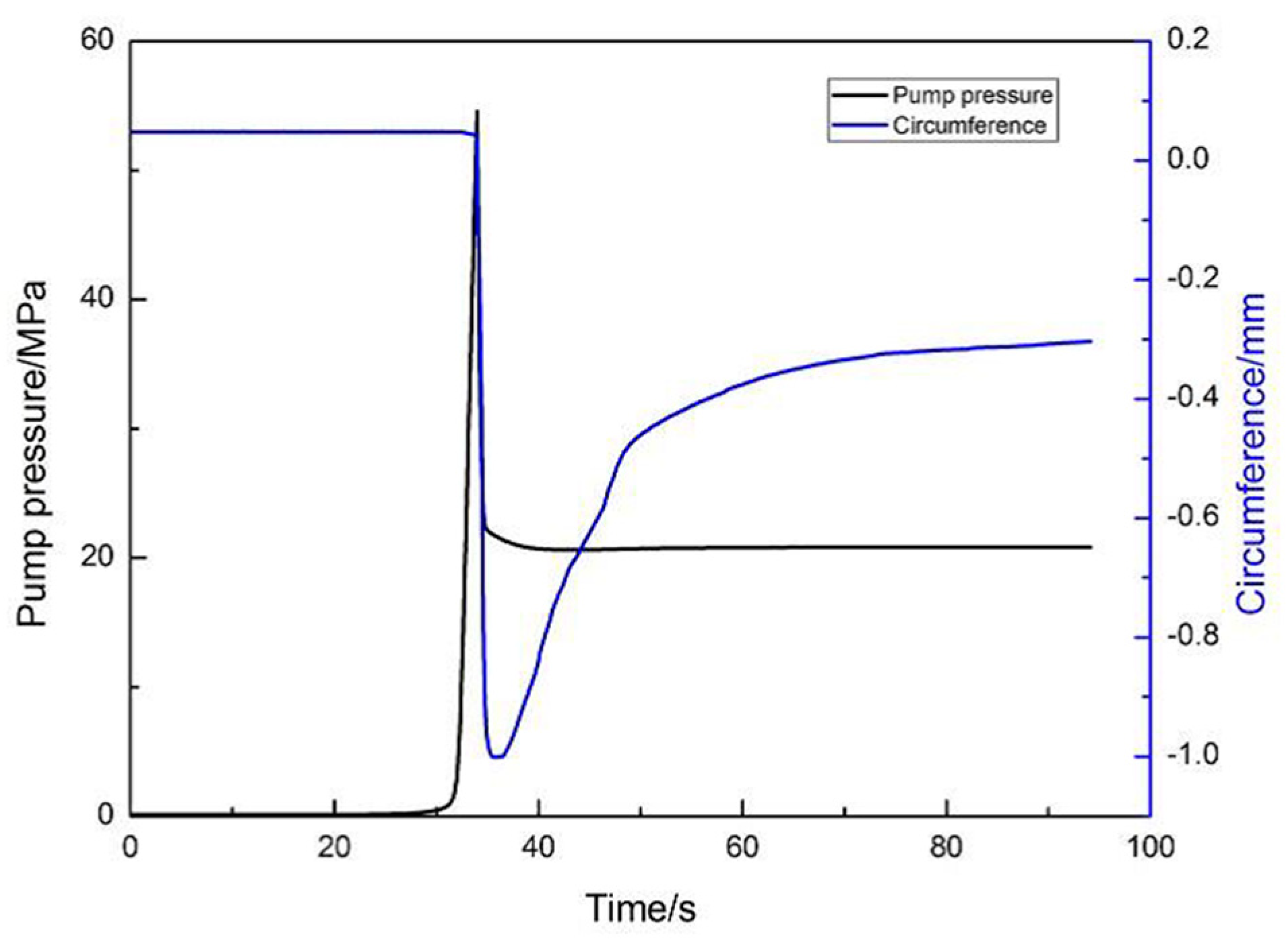
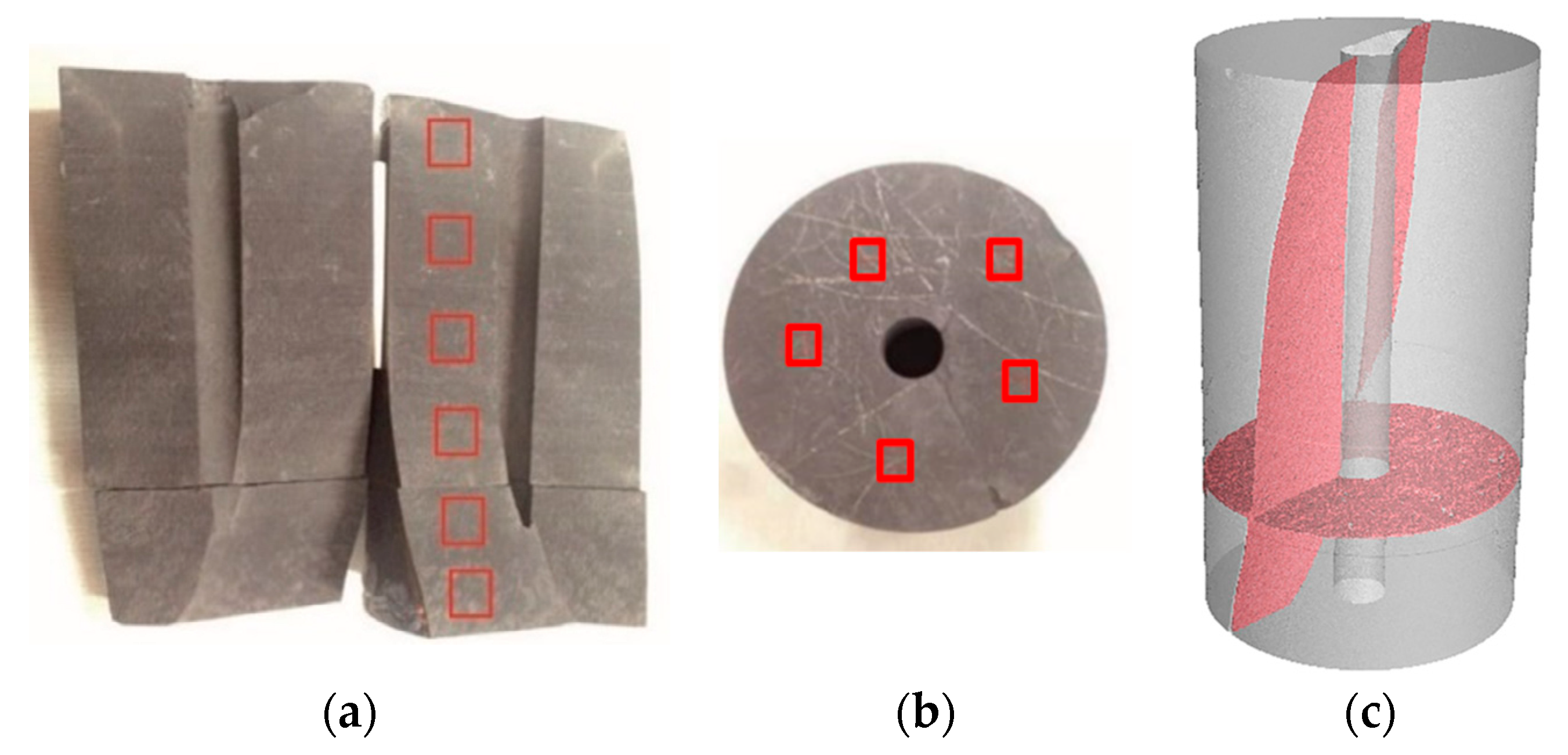
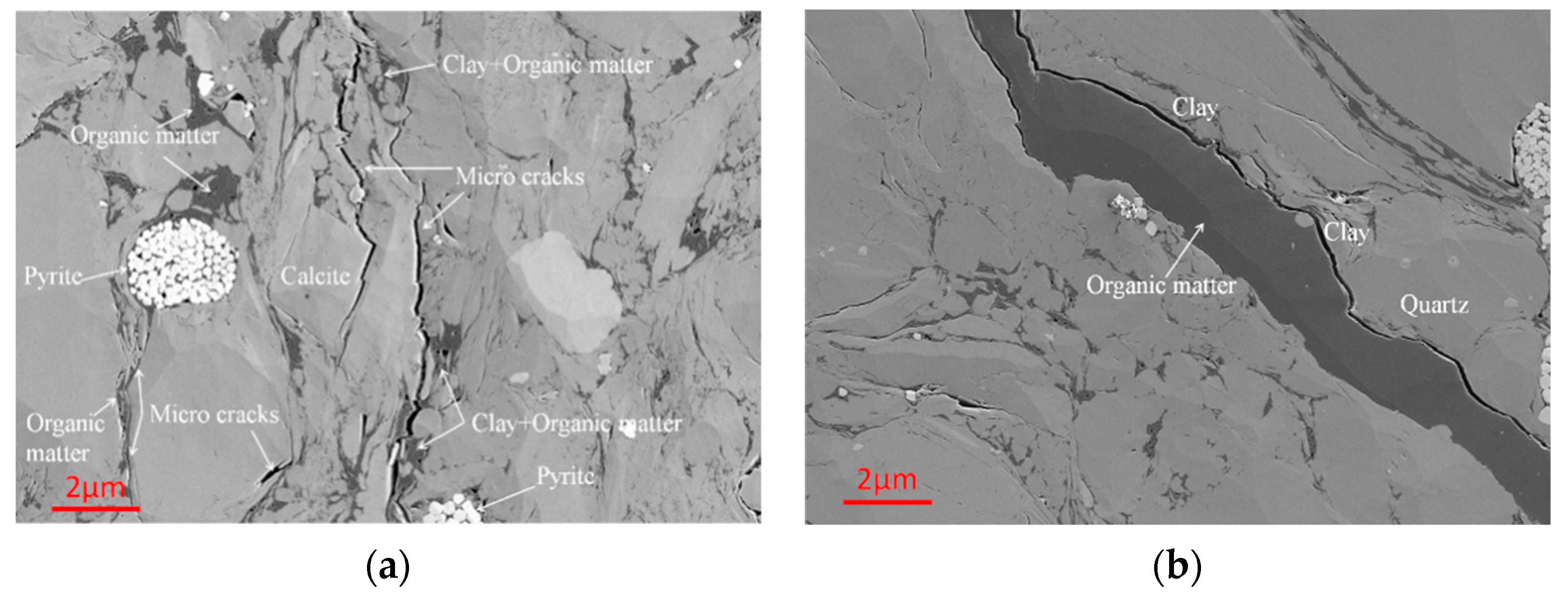

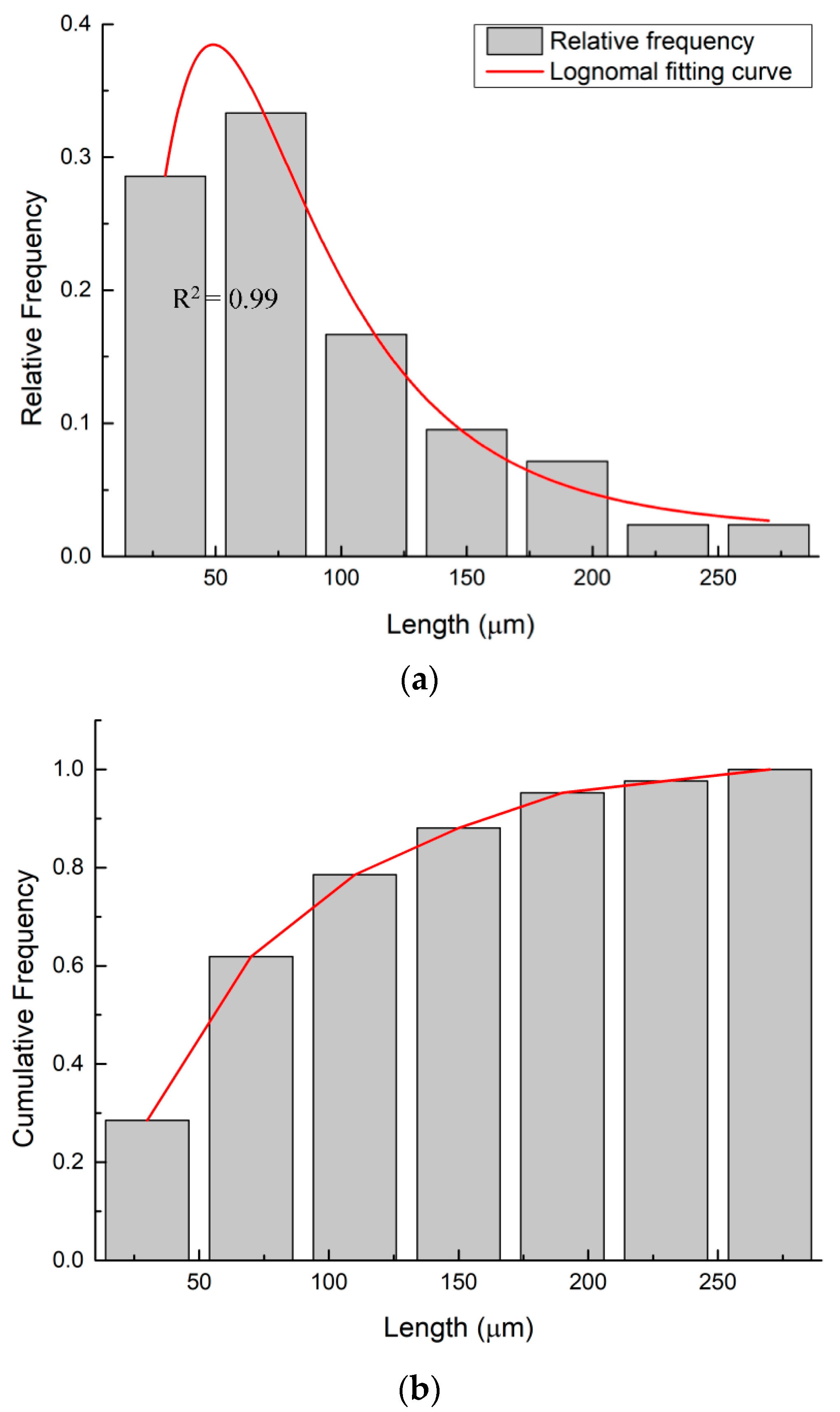
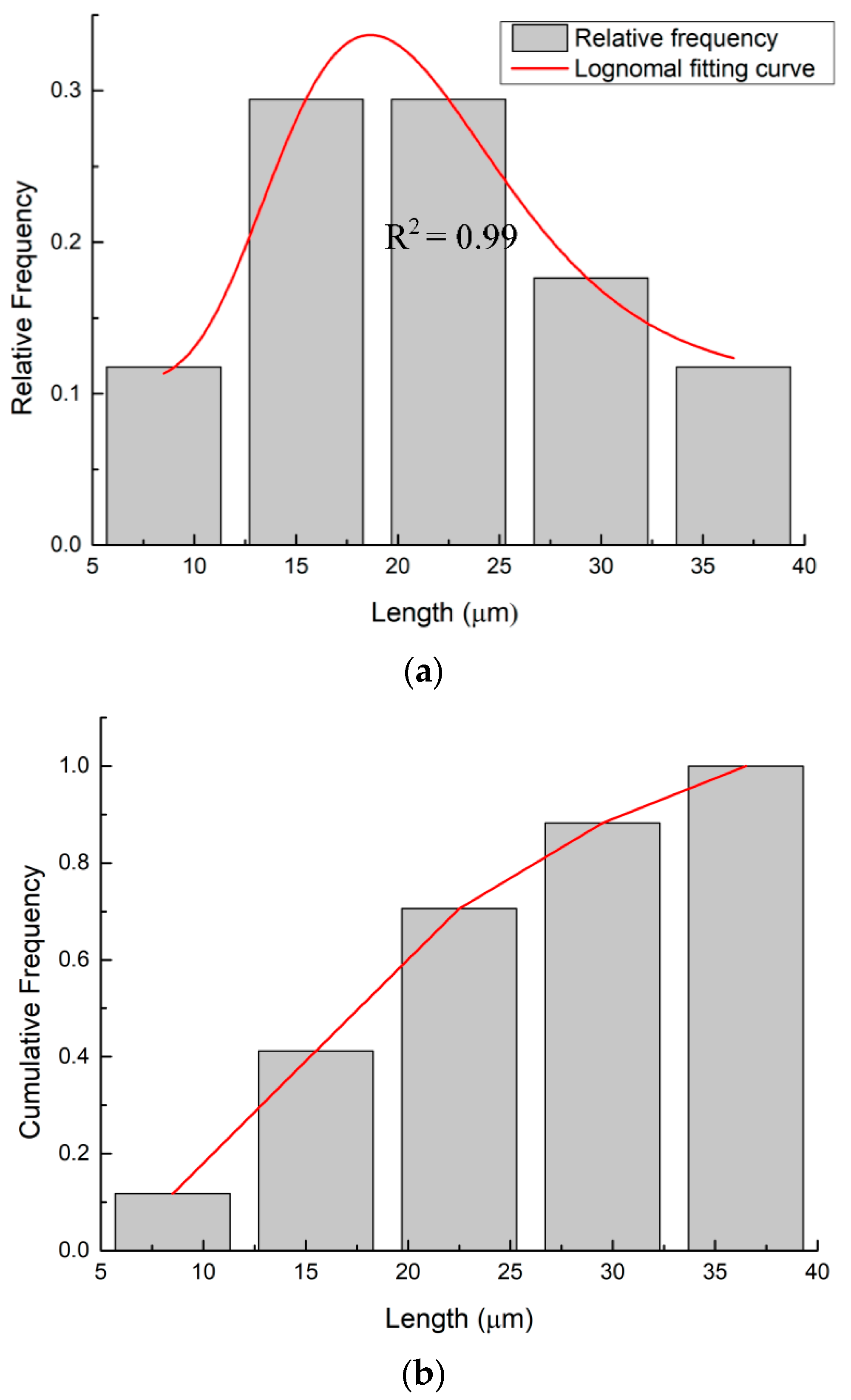
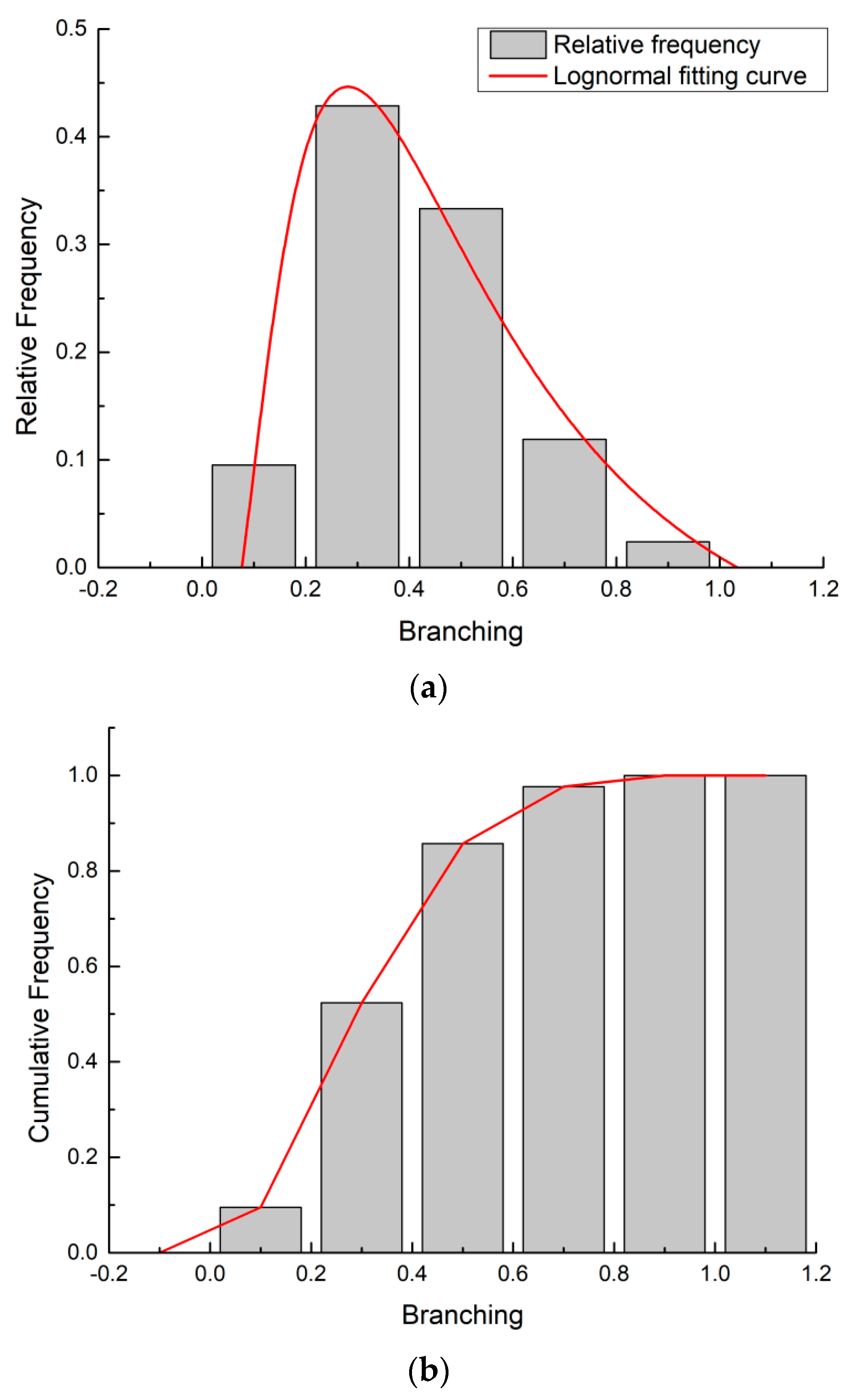
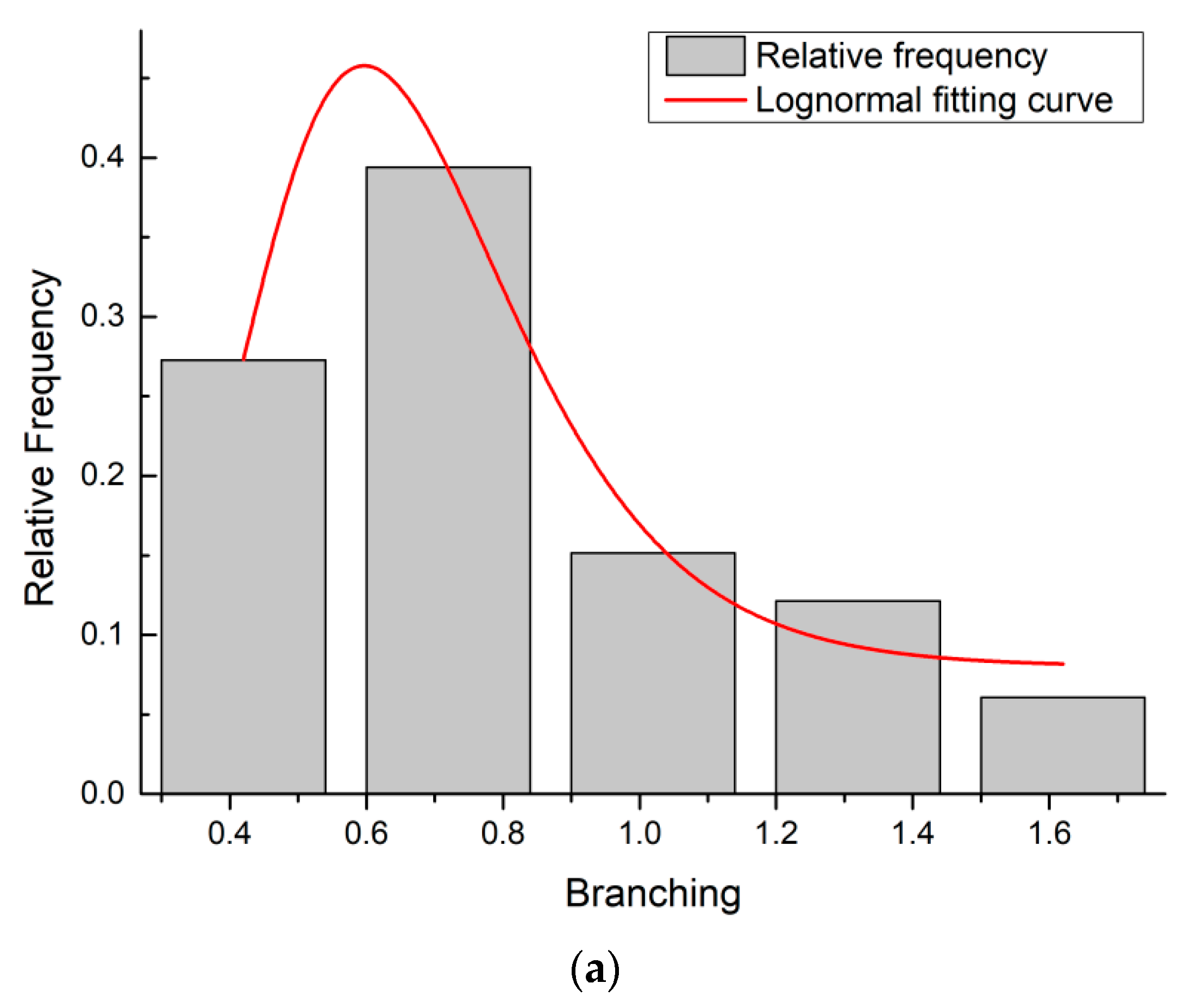
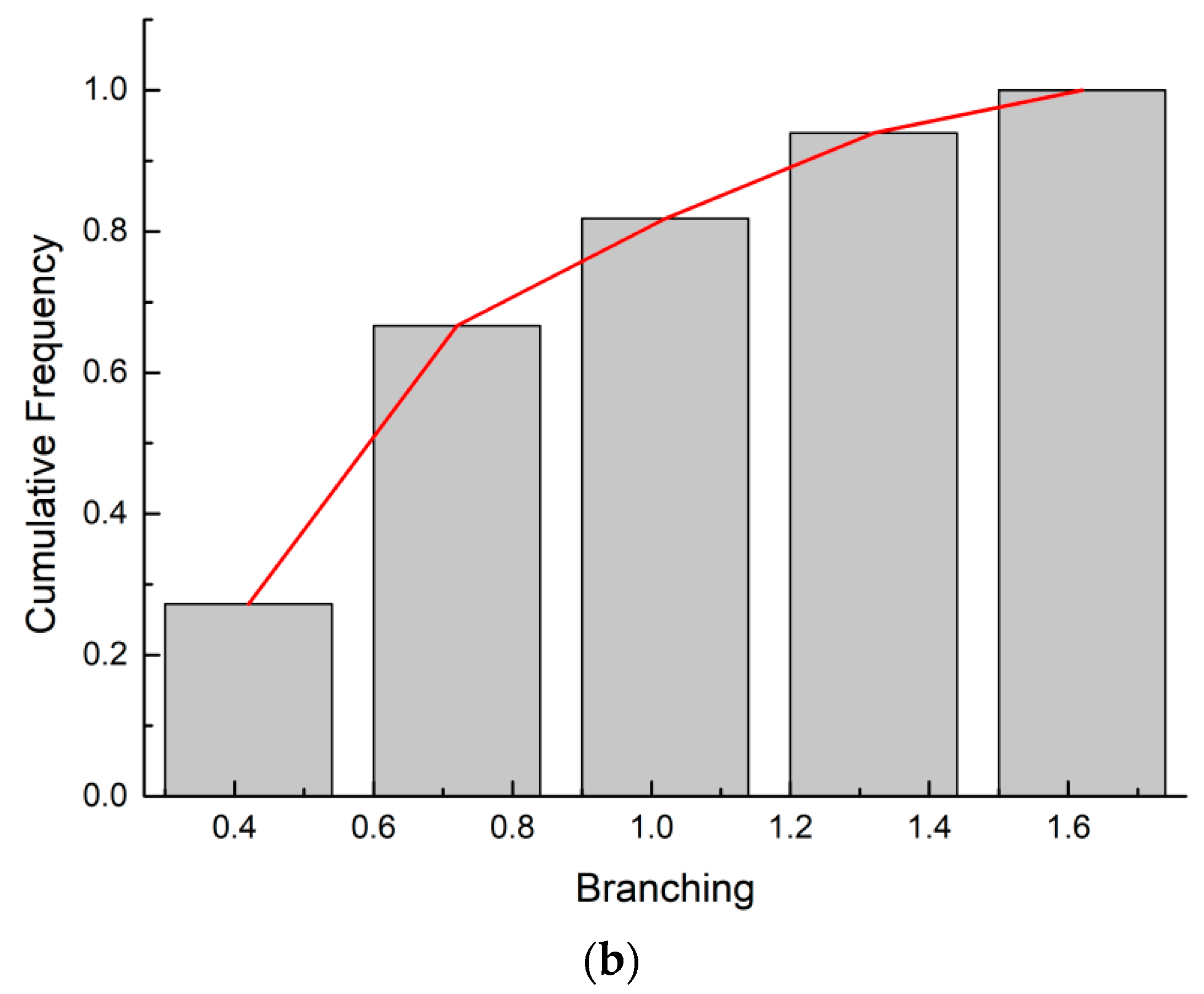
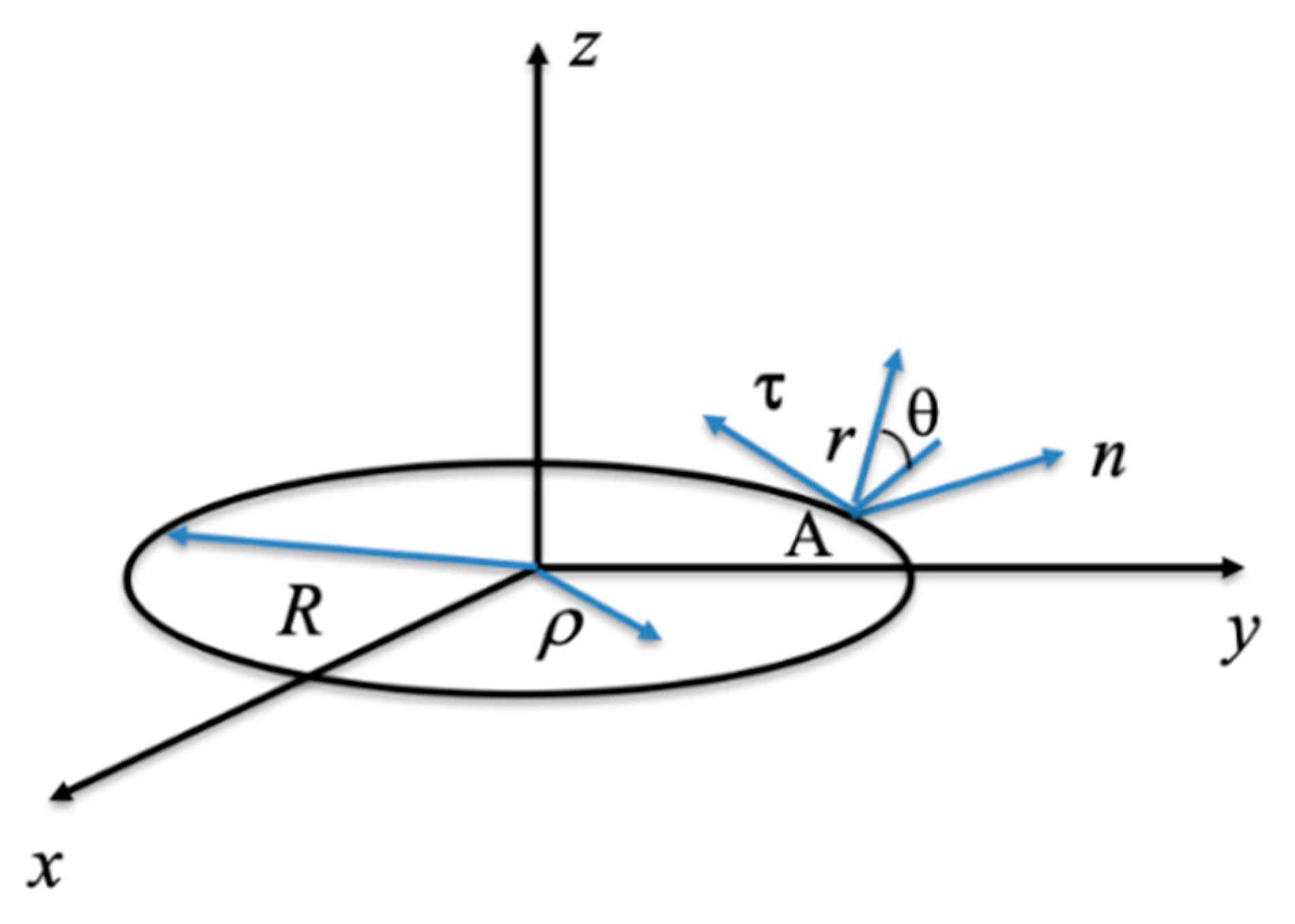
| Microcrack Pattern | Average Value (µm) | Standard Deviation (µm) |
|---|---|---|
| Newly PF | 92.62 | 57.49 |
| RF | 21.55 | 7.83 |
| Microcrack Pattern | δ | |||
|---|---|---|---|---|
| Newly PF | 4.34 | 0.63 | 93.69 | 65.71 |
| RF | 3.00 | 0.40 | 21.76 | 9.06 |
| Microcrack Pattern | Average Value (µm) | Standard Deviation (µm) |
|---|---|---|
| newly PF | 0.39 | 0.17 |
| RF | 0.87 | 0.38 |
Publisher’s Note: MDPI stays neutral with regard to jurisdictional claims in published maps and institutional affiliations. |
© 2022 by the authors. Licensee MDPI, Basel, Switzerland. This article is an open access article distributed under the terms and conditions of the Creative Commons Attribution (CC BY) license (https://creativecommons.org/licenses/by/4.0/).
Share and Cite
Qu, X.; Zhang, Y.; Liu, F.; He, J.; Dyskin, A.V.; Qi, C. An Experimental Analysis of Microcrack Generation during Hydraulic Fracturing of Shale. Coatings 2022, 12, 483. https://doi.org/10.3390/coatings12040483
Qu X, Zhang Y, Liu F, He J, Dyskin AV, Qi C. An Experimental Analysis of Microcrack Generation during Hydraulic Fracturing of Shale. Coatings. 2022; 12(4):483. https://doi.org/10.3390/coatings12040483
Chicago/Turabian StyleQu, Xiaolei, Yunkai Zhang, Fanyue Liu, Jianming He, Arcady V. Dyskin, and Chengzhi Qi. 2022. "An Experimental Analysis of Microcrack Generation during Hydraulic Fracturing of Shale" Coatings 12, no. 4: 483. https://doi.org/10.3390/coatings12040483
APA StyleQu, X., Zhang, Y., Liu, F., He, J., Dyskin, A. V., & Qi, C. (2022). An Experimental Analysis of Microcrack Generation during Hydraulic Fracturing of Shale. Coatings, 12(4), 483. https://doi.org/10.3390/coatings12040483







